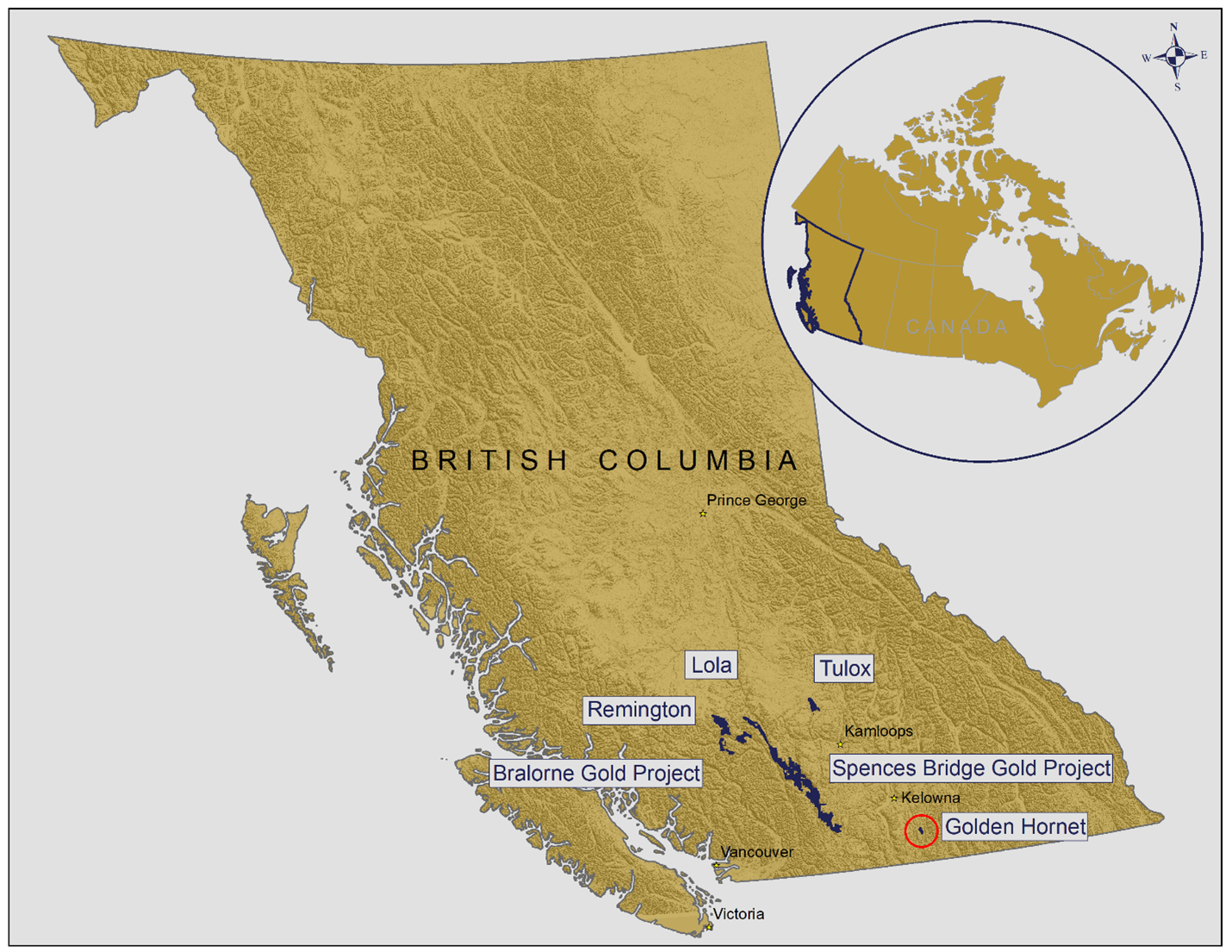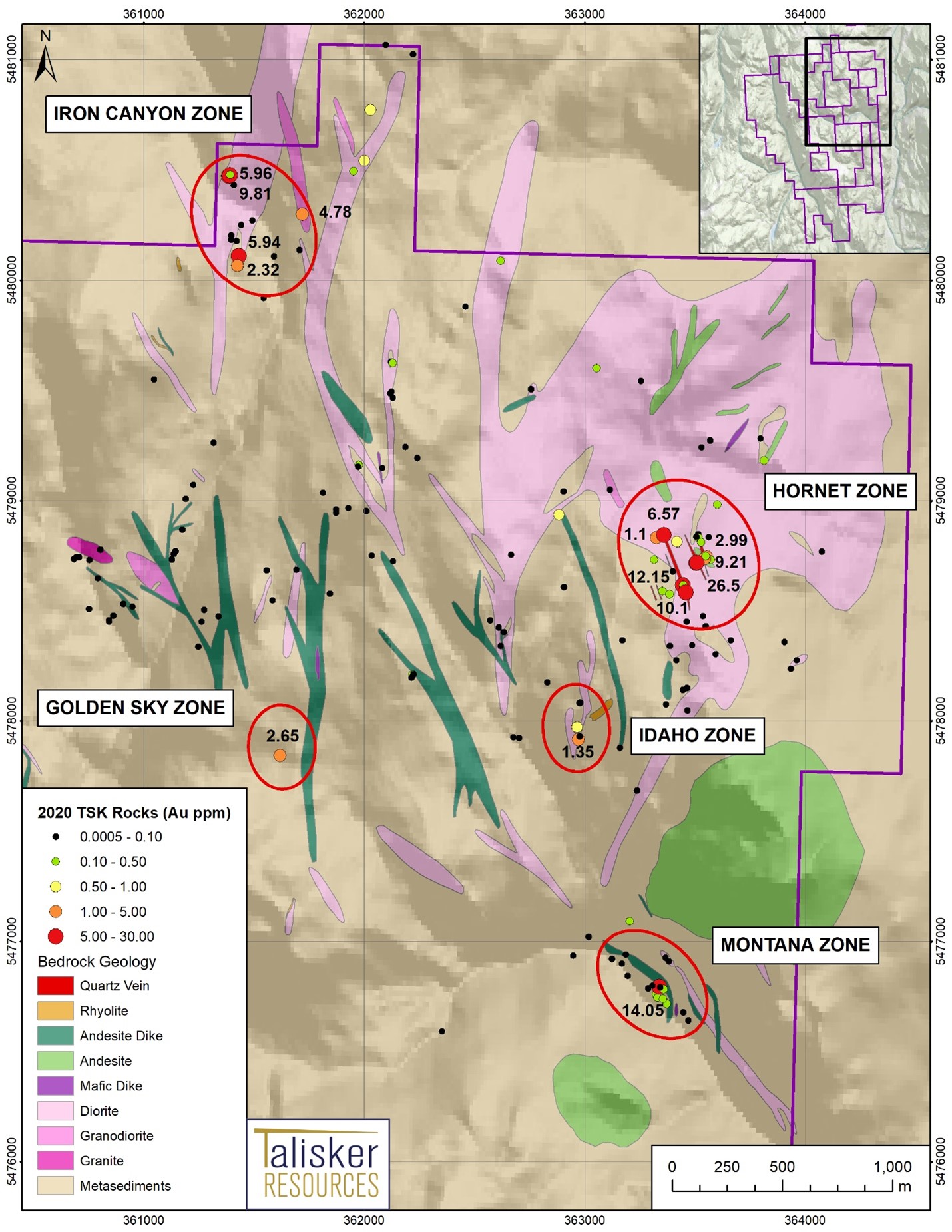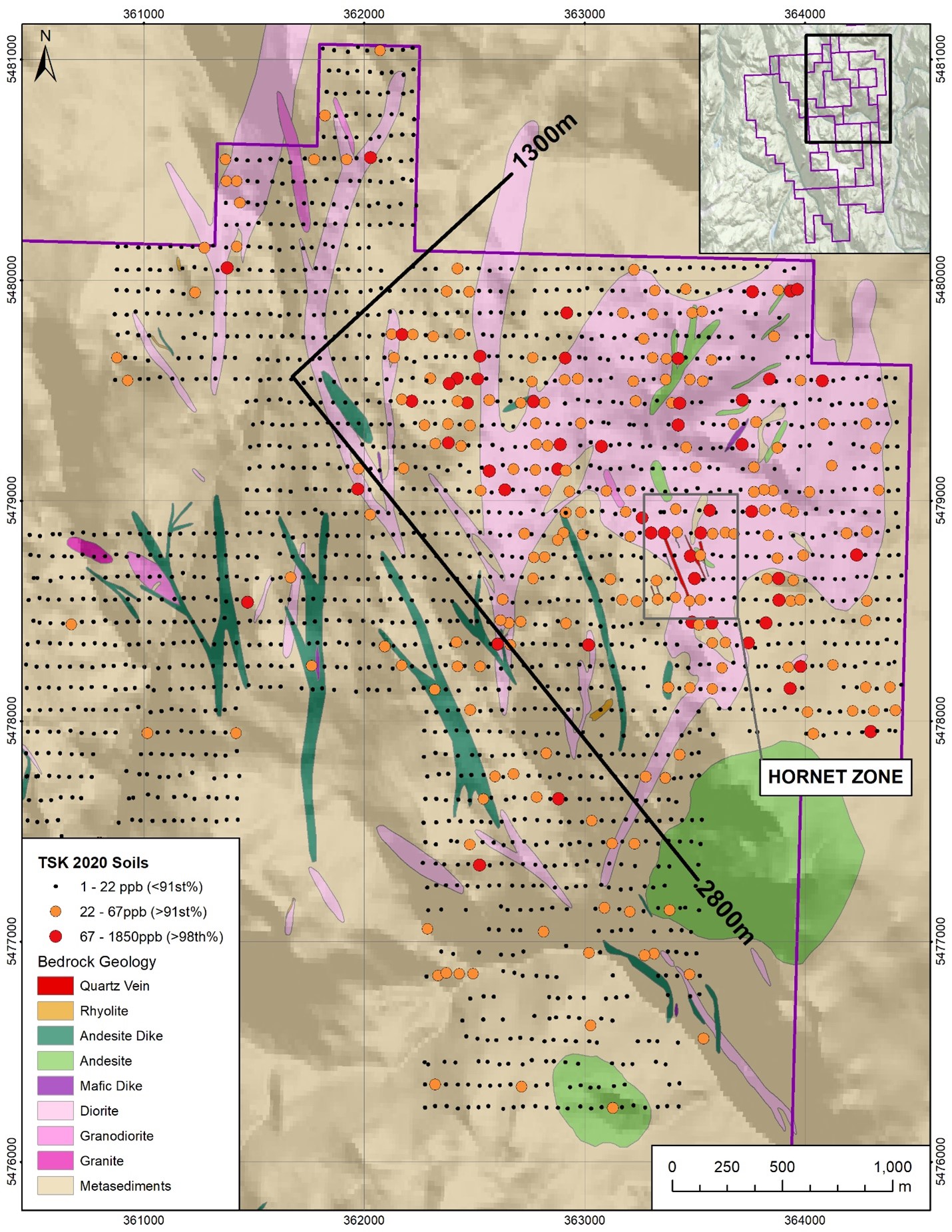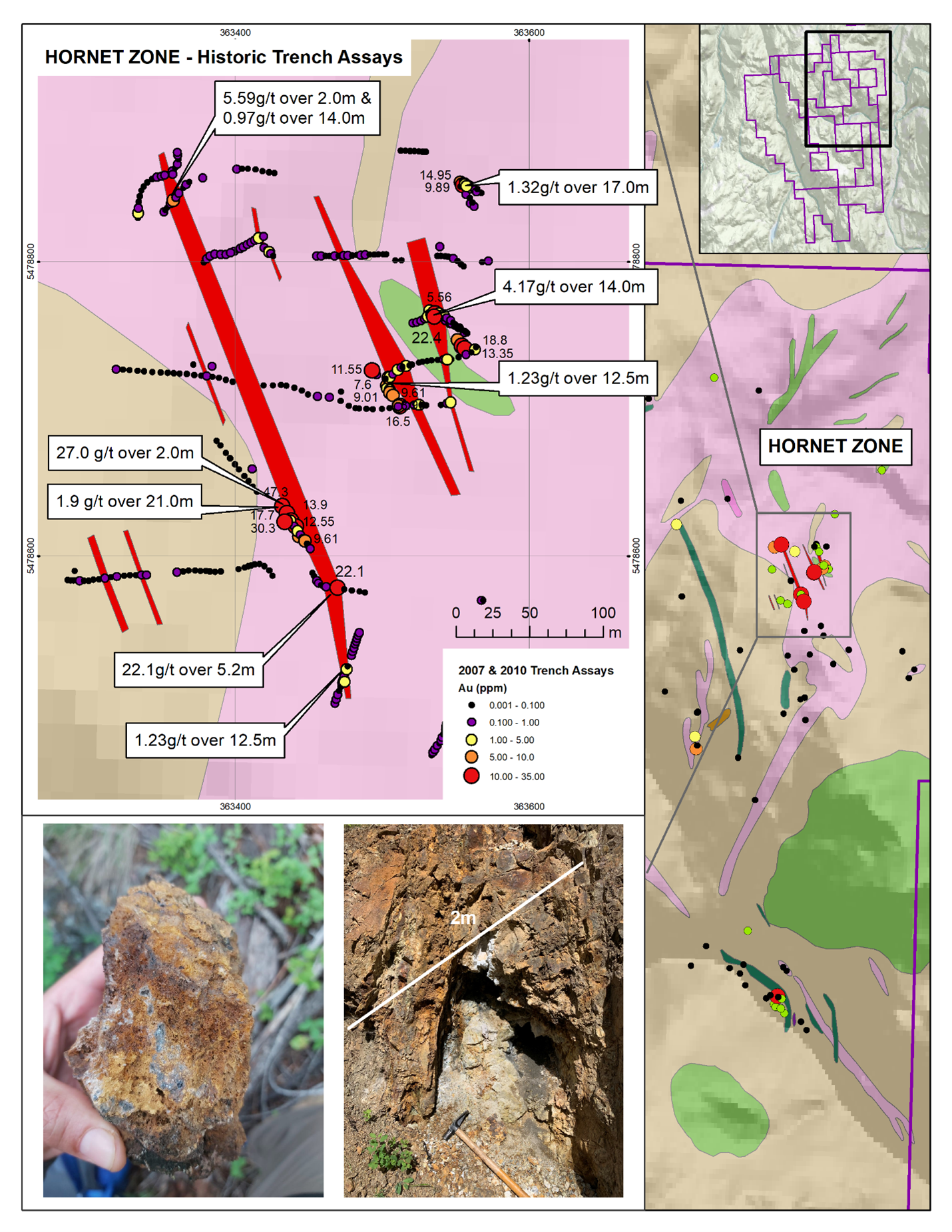Talisker Receives 26.5 g/t Gold Sample and Defines a 2.8 km x 1.3 km Gold in Soil Anomaly at the Golden Hornet Project

TORONTO, ON / ACCESSWIRE / January 26, 2021 / Talisker Resources Ltd. (“Talisker” or the “Company”) (TSX:TSK)(OTCQX:TSKFF) is pleased to announce assay results of a systematic rock and soil sampling program from its Golden Hornet Project located 23 kilometres from Rock Creek, British Columbia (Figure 1). The rock and soil sampling program was conducted during the 2020 field season in conjunction with a detailed structural mapping program.
Key Points:
- Gold-rich polymetallic sheeted vein complex identified
- 2,700 soil samples define a robust 2.8 km x 1.3 km multi-line, multi-station gold anomaly
- 210 rock samples validate high-grade historic channel samples of 27.0 g/t over 2.0 m[1] and 22.1 g/t over 5.2 m1
- Four mineralized outcropping vein zones including three newly discovered outcropping vein zones extending known historic mineralisation
- Veins surrounded by broad halos of outcropping disseminated sulphide mineralisation
- Polymetallic Montana Zone returned up to 14.05 g/t Au, 7.84% Zn, 1.8% Cu and 4.4% Pb
- Drill permit submitted, expecting receipt in early March
- First of four Greenfields drill projects planned for 2021
Terry Harbort, President and CEO of Talisker commented, “We are very pleased with the initial results of our 2020 exploration program at Golden Hornet. These results demonstrate the overall size potential of the mineralized system with robust soil anomalies extending along strike up to 1.5 km away from the previously known mineralized outcrops. We look forward to rapidly advancing to drill stage at Golden Hornet, the first of our four Greenfields drill targets slated for drill testing 2021.”
In addition to the rock and soil sampling program, Talisker also initiated a 1,093 line kilometre airborne Versatile Time-Domain Electromagnetic (VTEM) and Magnetic geophysical surveys to identify areas of high sulphide content, targeting both the massive sulphide vein systems and the surrounding disseminated sulphide halos. Results from the geophysics surveys are expected to be received shortly and will be correlated with the geochemistry to assist in confirming the drill plan.
Talisker has initiated permitting to drill a total of 6,700 metres testing all four mineralized zones, with the focus being the Main Hornet Zone. Drill Permit approval is expected in early March with drilling beginning shortly thereafter.
Rock Sampling Results
Talisker’s geologists collected a total of 210 rock samples over an extensive 10 km x 9 km area returning multiple high-grade values of up to 26.5 g/t Au, 1.8 % Cu, 7.84 % Zn and 4.4 % Pb with 17 samples focused in four main outcropping mineralized zones returning over 1 g/t gold (Figure 2).
Soil Sampling Results
A total of 2,700 B-horizon soil samples were collected to identify extensions of known mineralized zones and to confirm structural continuity between zones (Figure 3). A 2.8 km x 1.3 km northwest trending multi-line, multi-station gold in soil anomaly has been delineated with 55 samples returning values over the 98th percentile of 68 ppb Au and two samples returning over 1 g/t Au. These results identified multiple new targets along strike of the Main Hornet Zone, located in previously unexplored portions of the district.
Golden Hornet Project Highlights
Golden Hornet is divided into four zones including the Main Hornet Zone, plus three additional zones (Iron Canyon Zone, Montana Zone and Idaho Zone) that were discovered during Talisker’s Greenfields exploration program in 2020. Figure 2 shows the relative location of each zone.
Main Hornet Zone
A series of sheeted northwest trending 1 to 3 metre wide quartz-sulphide veins with disseminated sulphide halos exposed by historic trenching at the Main Hornet Zone (Figure 4). Talisker’s results define a series of seven veins outcropping over an area of 500 m x 300 m. Results include:
- Sample C0009931- 26.5 g/t Au (0.5 m Channel)
- Sample C0009293- 12.2 g/t Au (0.6 m Channel)
- Sample C0009771- 10.1 g/t Au (1.5 m Channel)
- Sample C0009938- 9.2 g/t Au (Grab)
- Sample C0009774- 6.6 g/t Au (Grab)
- Sample C0009935- 3.0 g/t Au (Grab)
- Sample C0009935- 1.64 g/t Au (Grab)
Talisker’s sampling adds to historic trench samples previous released by former operators from the Main Hornet Zone that included:
- 22.1 g/t Au over 5.2 m1
- 27.0 g/t Au over 2.0 m1
- 4.17 g/t Au over 14.0 m1
Iron Canyon Zone (New Discovery Zone)
Talisker geologists mapped a 1 to 2 metre wide quartz-sulphide vein with large disseminated lower-grade sulphide halos located 2.5 kilometres along strike from the Main Hornet Zone (Figure 2). Results include:
- Sample C0009295- 9.8 g/t Au (Grab)
- Sample C0009293- 5.96 g/t Au (1 m Channel)
- Sample C0009947- 5.94 g/t Au (1 m Channel)
- Sample C0009941- 4.78 g/t Au (Grab)
- Sample C0009921- 2.32 g/t Au (Grab)
Montana Zone (New Discovery Zone)
A series of polymetallic sheeted quartz-sulphide veins hosted within andesitic volcanic rock (Figure 2). Results include:
- Sample C0009184- 14.05 g/t Au, 0.62% Cu, 1.6% Pb, 4.4% Zn (Grab)
- Sample C0009128- 0.35 g/t Au, 91 g/t Ag, 1.8% Cu, 7.84% Zn (Grab)
- Sample C0009127- 0.3 g/t Au, 0.53% Pb (Grab)
- Sample C0009185- 0.28 g/t Au, 0.63% Cu, 5.37% Zn (Grab)
Idaho Zone (New Discovery Zone)
Small outcropping area hosted in hornfel (Figure 2). Although no veins were observed at Idaho due to the limited outcrop, significant areas of disseminated sulphide were identified. Results include:
- Sample C0009143- 1.35 g/t Au (0.75 m Channel)
- Sample C0009141- 0.65 g/t Au, 0.35% Cu (Grab)
About Golden Hornet
The Golden Hornet Project sits within the mining friendly Greenwood District, 21 kilometers north of Rock Creek, BC and covers 5,070.37 Ha, containing 21 gold showings. The Project area is easily accessible via major highway and contains a dense network of forestry roads allowing for year round access.
The Golden Hornet Project presents a large footprint, intrusion-related gold system hosting sheeted quartz-sulphide veins containing high-grade gold values associated with massive pyrite, arsenopyrite and pyrrhotite. The main northwest trending veins at the Main Hornet Zone outcrop continuously over a 500 m x 300 m area. Additional low-grade gold mineralization associated with disseminated sulphide and interstitial fracture veinlets is observed between the major veins indicating opportunity for bulk tonnage potential.
Talisker is providing an opportunity for shareholders and other interested parties to participate in a Webinar to be held at 4 pm ET on Thursday, January 28th. To register, please click on the following link – https://us02web.zoom.us/webinar/register/WN_rQYbWy_PQOihLwcnZz5TMg. After registering, you will receive a confirmation email containing information about joining the webinar.
About Talisker Resources Ltd.
Talisker (taliskerresources.com) is a junior resource company involved in the exploration of gold projects in British Columbia, Canada. Talisker’s projects include the Bralorne Gold Complex, an advanced stage project with significant exploration potential from a historical high-grade producing gold mine as well as its Spences Bridge Project where the Company holds ~85% of the emerging Spences Bridge Gold Belt and several other early-stage Greenfields projects. With its properties comprising 278,364 hectares over 256 claims, three leases and 198 crown grant claims, Talisker is a dominant exploration player in the south-central British Columbia. The Company is well funded to advance its aggressive systematic exploration program at its projects.
For further information, please contact:
Terry Harbort
President & CEO
Terry.harbort@talliskerresources.com
+1 416 361 2808
Mick Carew
VP, Strategic and Corporate Development
mick.carew@taliskerresources.com
+1 604 803 7711
Qualified Person
The technical information contained in this new release has been approved by Luis Arteaga, M.Sc. P.Geo. Talisker’s Exploration Manager, who is a “qualified person” within the meaning National Instrument 43-101, Standards of Disclosure for Mineral Projects.
Sample Preparation and QAQC
Sample preparation and analyses is carried out by ALS Global, at their laboratory in North Vancouver, British Columbia, Canada. Stream sediment sample preparation was includes drying in an oven at a maximum temperature of 60°C, sieve samples to -180 micron (-80 mesh), retaining both fractions (PREP-41). Rock sample preparation includes drying in an oven at a maximum temperature of 60°C, fine crushing of the sample to at least 70% passing less than 2 mm, sample splitting using a riffle splitter, and pulverizing a 250 g split to at least 85% passing 75 microns (code PREP-31).
Gold and multi-elements in soil samples is analyzed by aqua regia digestion of a 50 g sample split with detection by inductively coupled plasma mass spectrometer (ICP-MS) for 53 elements (Au, Ag, Al, As, B, Ba, Be, Bi, Ca, Cd, Ce, Co, Cr, Cs, Cu, Fe, Ga, Ge, Hf, Hg, In, K, La, Li, Mg, Mn, Mo, Na, Nb, Ni, P, Pb, Pd, Pt, Rb, Re, S, Sb, Sc, Se, Sn, Sr, Ta, Te, Th, Ti, Tl, U, V, W, Y, Zn, Zr) (Code AuMe-ST44).
Gold in rock samples is analyzed using fire assay of a 50 g sample split with detection by inductively coupled plasma atomic emission spectrometer (ICP-AES) (code Au-ICP21). Multi-elements are analyzed by aqua regia digestion of a 0.5 gram sub-sample with detection by inductively coupled plasma atomic emission spectrometer (ICP-AES) for 51 elements (Au, Ag, Al, As, B, Ba, Be, Bi, Ca, Cd, Ce, Co, Cr, Cs, Cu, Fe, Ga, Ge, Hf, Hg, In, K, La, Li, Mg, Mn, Mo, Na, Nb, Ni, P, Pb, Rb, Re, S, Sb, Sc, Se, Sn, Sr, Ta, Te, Th, Ti, Tl, U, V, W, Y, Zn, Zr) (code ME-MS41).
Caution Regarding Forward Looking Statements
Certain statements contained in this press release constitute forward-looking information. These statements relate to future events or future performance. The use of any of the words “could”, “intend”, “expect”, “believe”, “will”, “projected”, “estimated” and similar expressions and statements relating to matters that are not historical facts are intended to identify forward-looking information and are based on Talisker’s current belief or assumptions as to the outcome and timing of such future events. Actual future results may differ materially. In particular, this release contains forward-looking information relating to, among other things, the operations of the Company and the timing which could be affected by the current global COVID-19 pandemic. Those assumptions and factors are based on information currently available to Talisker. Although such statements are based on reasonable assumptions of Talisker’s management, there can be no assurance that any conclusions or forecasts will prove to be accurate.
While Talisker considers these assumptions to be reasonable based on information currently available, they may prove to be incorrect. Forward looking information involves known and unknown risks, uncertainties and other factors which may cause the actual results, performance or achievements to be materially different from any future results, performance or achievements expressed or implied by the forward-looking information. Such factors include risks inherent in the exploration and development of mineral deposits, including risks relating to changes in project parameters as plans continue to be redefined, risks relating to variations in grade or recovery rates, risks relating to changes in mineral prices and the worldwide demand for and supply of minerals, risks related to increased competition and current global financial conditions and the COVID-19 pandemic, access and supply risks, reliance on key personnel, operational risks, and regulatory risks, including risks relating to the acquisition of the necessary licenses and permits, financing, capitalization and liquidity risks.
The forward-looking information contained in this release is made as of the date hereof, and Talisker is not obligated to update or revise any forward-looking information, whether as a result of new information, future events or otherwise, except as required by applicable securities laws. Because of the risks, uncertainties and assumptions contained herein, investors should not place undue reliance on forward-looking information. The foregoing statements expressly qualify any forward-looking information contained herein.
Figure 1

Figure 2

Figure 3

Figure 4

[1] The Company notes that these selected samples are not necessarily representative of the mineralization hosted on the Property. Limited drilling has been completed within the Project.
SOURCE: Talisker Resources Ltd.
View source version on accesswire.com:
https://www.accesswire.com/625906/Talisker-Receives-265-gt-Gold-Sample-and-Defines-a-28-km-x-13-km-Gold-in-Soil-Anomaly-at-the-Golden-Hornet-Project